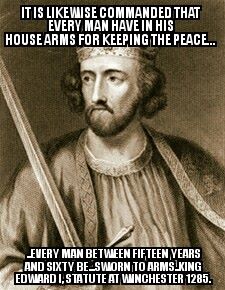The Power of a Tithing
From the Bible:
"So I took the chief of your tribes, wise men, and known, and made them heads over you, captains over thousands, and captains over hundreds, and captains over fifties, and captains over tens, and officers among your tribes." (Deuteronomy 1:15)
The Captains of Tens
that we read about in the Bible were called Tithingmen in Old English Common
Law, he was in charge of ten households, every male 12 to 60 was a part of the
Tithing, and they were responsible to act when their Tithingman made a Hue and
Cry. The Tithingman was responsible to make sure that those within his Tithing were
obedient to the law and trained in the use of arms.
Another term in medieval England for a tithing
group was “vill” (See Statute at Winchester).
While it may not be customary for Americans now to be split into
households of ten in these days, the common law practice of training men
beginning at the age of twelve years old in arms is implied in the Second
Amendment as part of “the people” who have those rights. The Boy Scouts were actually created with
this idea in mind and English Boy Scouts participated in the home front during
World War I taking the places of their older brothers who were called to the
battlefield. The Boy
Scouts ages 11-18 are able to earn merit badges for Rifle and Shotgun Shooting. These are usually the favorites among the
boys at their week long scout camps and you don't hear about mass shootings at
scout camps, due in part to the safety measures of the scouts and also their
moral code. Older Venture Scouts are
also trained in hand guns, beginning usually around the age of fourteen.
Constable:
Another term throughout history to describe the Tithingman is the
title of Constable. Though this term
originated with the Tithingmen it has been used in history to describe various
positions of power under the authority of a sheriff.
Frankpledge: According to many
historical sources, when William the Conqueror came to rule England, he
preserved the system that was in place with Tithingmen, placing each tithing on
a Frankpledge, meaning each member of the tithing would be responsible if
another member of the tithing fled from justice. It was their duty to raise Hue and Cry if a
member of their Tithing was attempting to flee justice and it would be their
duty to take up arms and pursue and capture him and keep him under watch till
he was brought to trial. This was the
origin of the bail system that we have today.
The Tithingman would answer to the Hundredman (Ruler of 10 Tithings or a hundred housholds) who would answer to the Shire Reeve or Sheriff of the Shire or County they were a part of. While the Tithingman had power over all males ages 12-60 to defend his tithing, the sheriff had power over all males 15 to 60 in "Posse Comitatus" and the King/President or Governor had power over all males 18-45 in the "Militia"
By the time the men reached the age for militia service they would have had 6 years of arms training already. Three years practicing to defend their town or village, and three years practicing under their sheriff to defend their county. In a case of state or national emergency where the Militia of the Whole would need to be activated, we would have well trained Militiamen ready to go at Moments Notice, without the burden of needing to train them in the use of arms.
Therefore, in the minds of the Founders, in order for a Well Regulated Militia to exist, the right of the PEOPLE to KEEP and BEAR ARMS could not be INFRINGED




Comments
Post a Comment